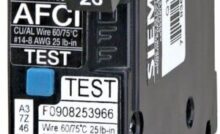How To Replace Light Fixture with Ceiling Fan


Before you start any electrical project make sure you shut off the electricity to the circuit you’re working on. Then make sure you test the circuit to make sure it’s in fact de-energized. Next you’ll want to remove the existing light fixture and existing electrical junction box. Most light fixtures will not be installed in a proper fan junction box. If you’re not sure then remove and get rid of the existing junction box. Typically a normal light fixture box will be mounted to the side of a ceiling joist. Once you remove the existing junction box you’ll be able to verify that.
If the existing junction box was attached to the side of the ceiling joist then you’ll want t

Next you’ll need to patch the hole left from the previous junction box (I’ll assume for now that you can figure this step out or read about patching drywall elsewhere). Once the ceiling is patched and painted you can install the ceiling fan according to the manufactures directions. Most likely in this scenario you’ll only have a single feed to you’ll have to switch the light and fan on with the switch and control the functions with pull chains.
The most important thing to remember here is that you should not install a ceiling fan in an existing electrical junction box that’s not rated for a fan. You can cause serious damage or injury to yourself or family if you do. Also make sure you understand and follow all electrical codes.
If you enjoyed this post and you’d like to read about why fans make the Green Grade over air conditioners then check out my post over at Today’s Green Construction.
Recent Posts
Framing Stick Nailer vs Coil Nailer
Which is Better a Stick Nailer or Coil Nailer? Framers have many choices in nailers…
How Many Roofing Nails Per Square of Shingles
Estimating How Many Nails for a New Roof When it comes to estimating materials for…
Composite / PVC Decking – Layout Tips & Advice
Composite / PVC Decking Layout Tips and Advice Composite and PVC decking have really changed…
Benefits of an ERV System (Energy Recovery Ventilator)
Benefits of ERV Systems (Energy Recovery Ventilator) If you're building a new home or doing…
Vermiculite Attic Insulation Abatement
Vermiculite Attic Insulation If your home was built before 1990 there is a chance it…
Nuisance Tripping of AFCI (Arc Fault) Circuit Breakers
Arc Fault (AFCI) Circuit Breakers Tripping Often An arc-fault circuit interrupter (AFCI) or arc-fault detection…

View Comments
I so want a ceiling fan... but my 6'4" husband has put a moratorium on them until we get a house with ceilings that aren't 8 feet. :) Looks like we'll be raising the ceilings sometime soon (back to their original height).
I'm 6'4"...8' ceilings in this house....maybe he should reconsider...they really don't bother me one bit!
Good article, Todd. Home Depot and Lowes also sell a box with extender arms that will reach out and pierce the joists on both sides to hold it firmly in place if you are trying to get the box to hang in the middle of the room and there's no joist perfectly in the middle. Our electrician at the prior house used those when he refinished ours.
Of course, if you have attic access to the room, you can just block between the joists and use your method.
We're considering a fan for our bedroom, but since we have 7'6" ceilings, it will be a low profile version without lights, and we'll put in recessed lights around it.
Be careful installing recessed lighting behind a ceiling fan. The lights must be set wider than the fan blades in order to avoid strobing. It may seem obvious, but when the fans are suspended the cone of unacceptable lighting placement is quite wide. There must be NO PLACE IN THE ROOM where you have a direct line of sight to the light through the fan circle.